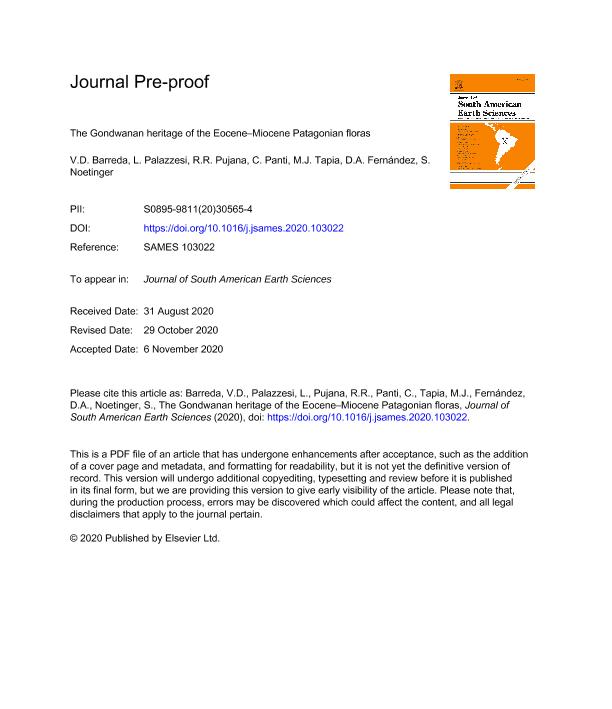Mostrar el registro sencillo del ítem
dc.contributor.author
Barreda, Viviana Dora

dc.contributor.author
Palazzesi, Luis

dc.contributor.author
Pujana, Roberto Roman

dc.contributor.author
Panti, Carolina

dc.contributor.author
Tapia, Mariano Jesús

dc.contributor.author
Fernández, Damián Andrés

dc.contributor.author
Noetinger, Maria Sol

dc.date.available
2021-05-14T13:51:32Z
dc.date.issued
2020-11
dc.identifier.citation
Barreda, Viviana Dora; Palazzesi, Luis; Pujana, Roberto Roman; Panti, Carolina; Tapia, Mariano Jesús; et al.; The Gondwanan heritage of the Eocene–Miocene Patagonian floras; Pergamon-Elsevier Science Ltd; Journal of South American Earth Sciences; 107; 11-2020; 1-56
dc.identifier.issn
0895-9811
dc.identifier.uri
http://hdl.handle.net/11336/132079
dc.description.abstract
The breakup of Gondwana and the associated climatic changes led to the fragmentation of floras that were once connected across the Southern lands. The diversity of the Gondwanan remnants has long been assumed to have fluctuated in Patagonia across the Cenozoic, although it has never been quantified so far. Here we address when the major floristic members of the Gondwanan legacy (e.g., southern beeches, proteas, podocarps, gumtrees) expanded, contracted, or became extinct during the Patagonian biogeographic isolation (Eocene–Miocene) on the basis of the re-assessment of the fossil record (i.e., woods, leaves, and spore-pollen grains). We found that the Patagonian floras experienced moderate to severe shifts in the diversity of the Gondwanan component —relative to the total flora— with the highest estimates in the late Eocene–early Oligocene (~50%) and the lowest estimates in the late Miocene (~20%) according to the fossil pollen record. The most important floristic changes include two major replacements: 1) tropical Gondwanan taxa (e.g., Akania, Eucalyptus, Gymnostoma) by typically cool-temperate taxa (e.g., Nothofagaceae) in the Eocene, and 2) humid taxa (e.g., Podocarpaceae) by arid-adapted floras, mostly of non-Gondwanan affinity, across the Miocene. The variation in diversity of the Gondwanan component from Patagonia shows a striking resemblance to that from Australia for the same period, probably indicating a global-scale driver of floristic turnover (e.g., global cooling conditions). Today, the Patagonian subantarctic forests harbor only about ~15% of the Gondwanan diversity, representing a three-fold decrease from its climax in the late Eocene–early Oligocene.
dc.format
application/pdf
dc.language.iso
eng
dc.publisher
Pergamon-Elsevier Science Ltd

dc.rights
info:eu-repo/semantics/openAccess
dc.rights.uri
https://creativecommons.org/licenses/by-nc-nd/2.5/ar/
dc.subject
DIVERSITY
dc.subject
FOSSILS
dc.subject
GONDWANA
dc.subject
PALEOFLORA
dc.subject
PATAGONIA
dc.subject.classification
Paleontología

dc.subject.classification
Ciencias de la Tierra y relacionadas con el Medio Ambiente

dc.subject.classification
CIENCIAS NATURALES Y EXACTAS

dc.title
The Gondwanan heritage of the Eocene–Miocene Patagonian floras
dc.type
info:eu-repo/semantics/article
dc.type
info:ar-repo/semantics/artículo
dc.type
info:eu-repo/semantics/publishedVersion
dc.date.updated
2021-04-28T21:29:10Z
dc.journal.volume
107
dc.journal.pagination
1-56
dc.journal.pais
Estados Unidos

dc.description.fil
Fil: Barreda, Viviana Dora. Consejo Nacional de Investigaciones Científicas y Técnicas. Oficina de Coordinación Administrativa Parque Centenario. Museo Argentino de Ciencias Naturales "Bernardino Rivadavia"; Argentina
dc.description.fil
Fil: Palazzesi, Luis. Consejo Nacional de Investigaciones Científicas y Técnicas. Oficina de Coordinación Administrativa Parque Centenario. Museo Argentino de Ciencias Naturales "Bernardino Rivadavia"; Argentina
dc.description.fil
Fil: Pujana, Roberto Roman. Consejo Nacional de Investigaciones Científicas y Técnicas. Oficina de Coordinación Administrativa Parque Centenario. Museo Argentino de Ciencias Naturales "Bernardino Rivadavia"; Argentina
dc.description.fil
Fil: Panti, Carolina. Consejo Nacional de Investigaciones Científicas y Técnicas. Oficina de Coordinación Administrativa Parque Centenario. Museo Argentino de Ciencias Naturales "Bernardino Rivadavia"; Argentina
dc.description.fil
Fil: Tapia, Mariano Jesús. Consejo Nacional de Investigaciones Científicas y Técnicas. Oficina de Coordinación Administrativa Parque Centenario. Museo Argentino de Ciencias Naturales "Bernardino Rivadavia"; Argentina
dc.description.fil
Fil: Fernández, Damián Andrés. Consejo Nacional de Investigaciones Científicas y Técnicas. Centro Austral de Investigaciones Científicas; Argentina
dc.description.fil
Fil: Noetinger, Maria Sol. Consejo Nacional de Investigaciones Científicas y Técnicas. Oficina de Coordinación Administrativa Parque Centenario. Museo Argentino de Ciencias Naturales "Bernardino Rivadavia"; Argentina
dc.journal.title
Journal of South American Earth Sciences

dc.relation.alternativeid
info:eu-repo/semantics/altIdentifier/doi/http://dx.doi.org/10.1016/j.jsames.2020.103022
dc.relation.alternativeid
info:eu-repo/semantics/altIdentifier/url/https://www.sciencedirect.com/science/article/abs/pii/S0895981120305654?via%3Dihub
Archivos asociados
